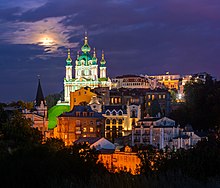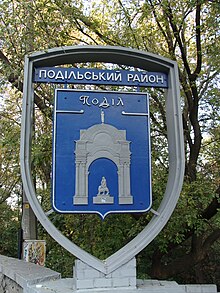Podil
Podil or Podol[1] (Ukrainian: Поділ [poˈdʲiɫ]) or the Lower city[2] is a historic neighborhood in Kyiv, the capital of Ukraine.
[2] In documentary sources there is mention of "Stolpiye" (wooden fortifications) that protected Podil from northwest, Fairgrounds (later Zhytniy Fairgrounds, main city market), Church of Saint Elijah (the oldest Christian temple mentioned in 945), and Pyrohoshcha Church.
[2] Podil has accumulated a cultural layer built up of 6–12 metres (20–39 feet) saturated with a great abundance of artefacts of 9–18th centuries.
[2] Its uniqueness consists of the fact that in its lower strata due to high soil moisture are well-preserved objects of organic matter such as wooden structures.
[2] There were researched residential and commercial buildings (predominantly above-ground blockhouses), craftsman shops, port warehouses, burial grounds, segments of streets.
[2] After the Mongol invasion of Rus' and destruction of Kyiv, Podil transformed into the main and the most populated part of the city.
[3] The center of Podil became the market square later known as Mahistratska and Konstraktova where stood a rathaus and the city's cathedral Pyrohoshcha Church.
[5] At the western end of the square was the Pyrohoshcha Church mentioned in the 12th century epic poem The Tale of Igor's Campaign.
[3] Not far from Kontraktova Square at Podil were the Zhytniy (Rye) Fairgrounds that existed at least since the 15th century where the main Roman Catholic cathedral Kosciol of Virgin Mary was located.
[5] Until World War II, the section just north of Nyzhniy Val street was called Ploska chast or Ploskaya sloboda.
[6][7][8] Numerous tourist attractions (also officially designated as landmarks) of Podil particularly include: Podil is connected to the city's metro system by the following three stations on the Obolonsko–Teremkivska line: Tarasa Shevchenka, Kontraktova Ploshcha (named after the Kontraktova Square) and Poshtova Ploshcha (named after the Poshtova Square).
The Kyiv Funicular provides passenger traffic between Podil and the city's historic Uppertown neighborhood, today it is mostly used by tourists.






